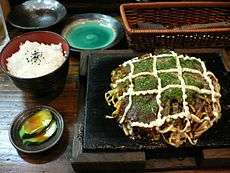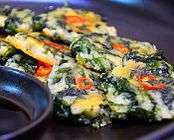Green laver
Green laver, known as aonori (アオノリ; 青海苔) in Japan and parae (파래) in Korean, is a type of edible green seaweed, including species from the genera Monostroma and Ulva (Ulva prolifera, Ulva pertusa, Ulva intestinalis). It is commercially cultivated in some bay areas in Japan, Korea, and Taiwan, such as Ise Bay. It is rich in minerals such as calcium, magnesium, lithium, vitamins, and amino acids such as methionine. It is also called aosa (アオサ, Ulva pertusa) in some places in Japan.[1]
.jpg)
Culinary use
Japan
It is used in its dried form for Japanese soups, tempura, and material for manufacturing dried nori and tsukudani and rice. It is also used in a powdered form, often blended with Ulva species of Ulvaceae as its production is limited.
It is used commonly for flavouring of some Japanese foods, usually by sprinkling the powder on the hot food, for its aroma:
- Fried noodles (yakisoba or yakiudon)
- Okonomiyaki (Japanese pancake)
- Takoyaki (octopus dumpling ball)
- Isobe age
- Isobe mochi
- Shichimi (seven-spice seasoning)
- Japanese potato chips
- Misoshiru
Korea
In Korea, parae is eaten as a namul vegetable. It is also used to make gim (dried laver sheets).
References
- "About 'aosanori'". isekanbutsu. Retrieved 25 May 2017.
External links

- Seaweeds used as human food
- Mystery Seaweed and Aonori


_(Monostroma_nitidum).jpg)